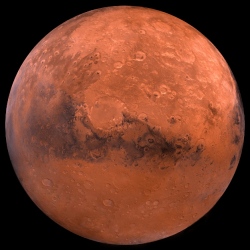
A team of researchers from Utrecht University in the Netherlands studied images of the Martian crater Istok, taken by the High Resolution Imaging Science Experiment camera on Nasa’s Mars Reconnaissiance Orbiter, to analyse whether the now barren planet once had active water sources.
The study, published in Nature Communications, found that gullies and deposits of sediment on Istok’s slopes resemble similar debris flows, caused by moving water, here on Earth. The researchers believe that the tracks would have had about twenty to sixty percent water content in them, and were caused by melting ice.
Furthermore, as Istok is relatively young, formed around one million years ago, it seems that these watery debris flows occurred in the Red Planet’s recent history; likely in one of its more recent ice ages.
Earth scientist Tjalling de Haas, lead author of the paper, commented: "I was actually really quite surprised to discover the volume and activity of water required to explain the [gullies] and debris in the crater."
